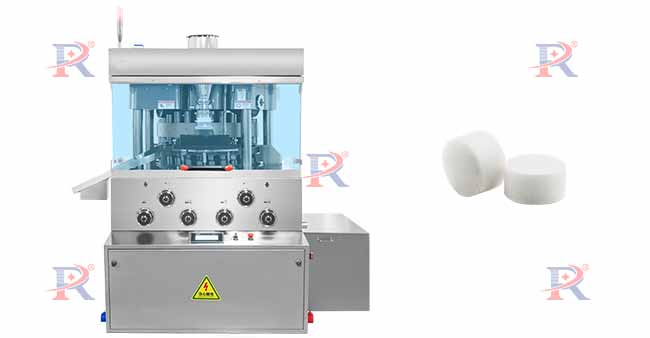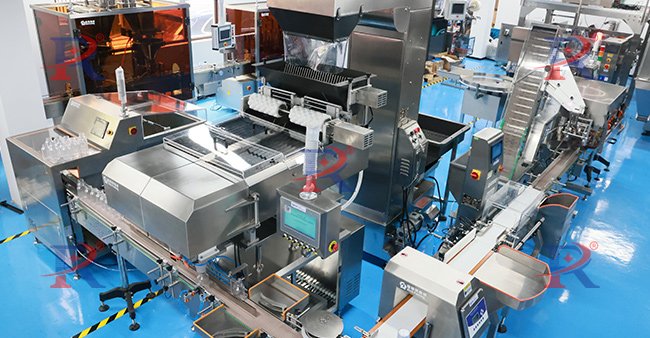الفقاعة (Blister) هي طريقة تعبئة شائعة الاستخدام، تُشكّل هياكل فقاعات بأحجام وأشكال مختلفة عن طريق تسخين المواد البلاستيكية واستخدام قوالب واختلافات الضغط. تُستخدم آلات التعبئة بالفقاعة على نطاق واسع في صناعات الأدوية والأغذية والعناية الشخصية ومستحضرات التجميل. وفقًا لعمليات الإنتاج المختلفة، يمكن تقسيمها إلى قولبة ساخنة، وقولبة باردة، وأسطوانية، ومسطحة، وغيرها، لتلبية احتياجات المنتجات المختلفة. ستجد أدناه وصفًا تفصيليًا للأنواع الرئيسية لآلات التعبئة بالفقاعة.
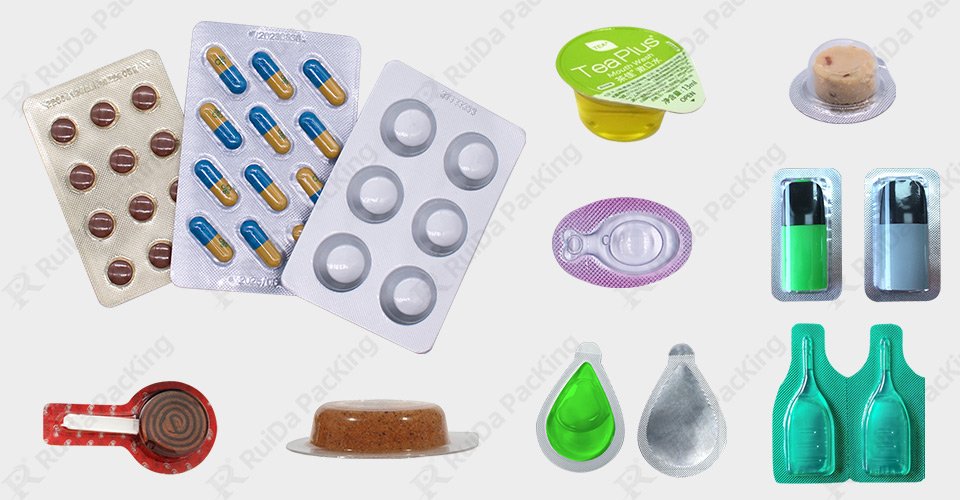
آلات التغليف بالحرارة - كيفية عملها
يتم إكمال العملية عن طريق تشكيل تجاويف فردية مفردة أو متعددة في الشكل المطلوب باستخدام الضغط أو الضغط الهوائي، ووضع المنتج في التجاويف من خلال أنبوب هابط، وإغلاقها بمادة داعمة (عادةً رقائق الألومنيوم أو الورق المقوى)، ثم ثقبها وتغطيةها في ألواح فردية.
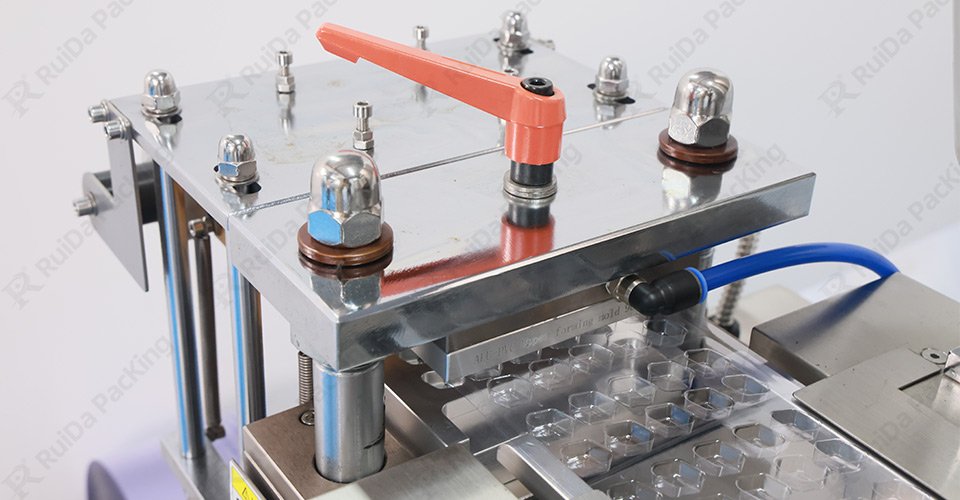
سمات
- التنوع: يمكن لآلات التشكيل الحراري استيعاب مواد مختلفة مثل PVC وPET وPP.
- السرعة العالية: القدرة على إنتاج كميات كبيرة في وقت قصير.
- التخصيص: يمكن تكوين الآلات لإنشاء أشكال وأحجام مختلفة من البثور.
التطبيقات
تُستخدم آلات التغليف بالحرارة على نطاق واسع في صناعة الأدوية لتعبئة الأقراص والكبسولات، وفي السلع الاستهلاكية لعناصر مثل البطاريات والألعاب، وفي صناعة الإلكترونيات لمنتجات مثل محركات أقراص USB والكابلات.
آلات التغليف بالبثور على البارد - كيف تعمل؟
تستخدم آلات التغليف بالبثور على البارد عملية ضغط رقاقة من رقائق الألومنيوم في قالب لتكوين تجاويف دون استخدام الحرارة. عادةً ما تُغلّف رقاقة الألومنيوم بالبلاستيك ومواد أخرى لتحسين خصائصها العازلة. بعد تشكيل التجاويف، تُدخل المنتجات، وتُغلَق العبوة بطبقة ثانوية من مادة، عادةً ما تكون غشاءً قابلاً للإغلاق الحراري.
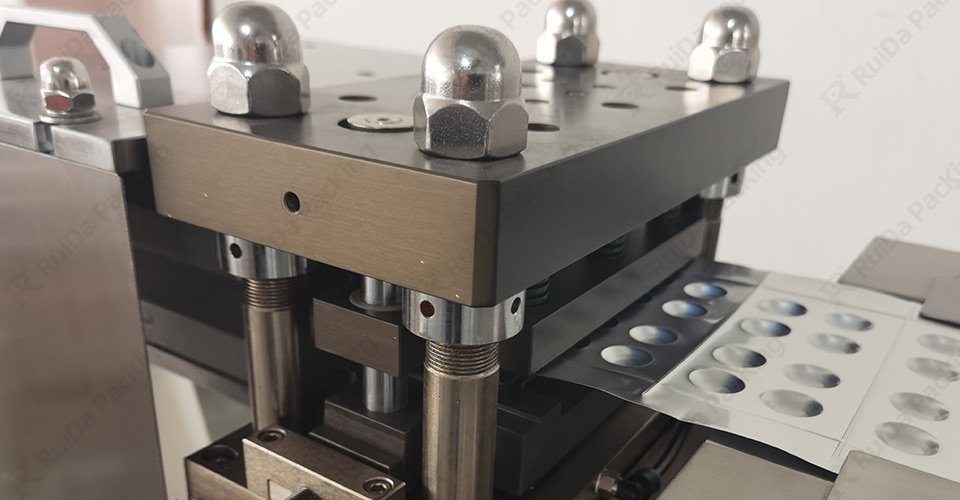
سمات
- حماية حاجزة فائقة: يوفر التشكيل البارد حاجزًا ممتازًا ضد الرطوبة والضوء والأكسجين، مما يجعله مثاليًا للمنتجات الحساسة.
- المتانة: تتميز العبوة بالقوة والقدرة على حماية العناصر الهشة أثناء النقل.
- عمر تخزين أطول: تعمل التغليفات المشكلة على البارد على إطالة عمر تخزين المنتجات من خلال توفير حماية أفضل.
التطبيقات
تُستخدم آلات التغليف بالبثور على البارد بشكل رئيسي في صناعة الأدوية لتغليف المنتجات الحساسة للرطوبة، مثل الكبسولات والأقراص وبعض الأجهزة الطبية. وتُقدّر هذه التقنية بشكل خاص لضمان استقرار المنتج وسلامته طوال دورة حياته.
آلة تعبئة الفقاعات عالية السرعة بالأسطوانات - كيفية عملها
آلة تعبئة نفطة عالية السرعة بالأسطوانة تُستخدم بكرات مستمرة لتشكيل تجاويف نفطة وإغلاق المنتج. تتضمن العملية تمرير غشاء بلاستيكي عبر بكرات ساخنة تُشكّل التجاويف. بعد التشكيل، يُوضع المنتج في التجاويف، وتُوضع مادة مانعة للتسرب، عادةً ما تكون رقائق الألومنيوم. ثم يُثقب المنتج النهائي ويُقطّع إلى عبوات منفصلة.
سمات
- إنتاج عالي السرعة: مصمم لتلبية احتياجات الإنتاج الضخم، وإنتاج تشكيل مستمر للتصنيع عالي السرعة.
- الاتساق: يضمن الأداء الفعال والمستقر مطابقة التعبئة والتغليف ودقتها أثناء عمليات الإنتاج الطويلة.
- الكفاءة: تعمل الآلات ذات الأسطوانة على زيادة كفاءة الإنتاج عن طريق تقليل وقت التوقف.
التطبيقات
تُستخدم آلات التغليف بالبثور ذات الأسطوانة عادةً في الصناعات التي تتطلب تغليفًا عالي السرعة، مثل الأغذية والمشروبات، والأدوية، والإلكترونيات. وهي مثالية للمنتجات التي تحتاج إلى تعبئة بكميات كبيرة بجودة ثابتة.
آلات التغليف بالبثور ذات الألواح المسطحة وكيفية عملها
آلة تعبئة نفطة مسطحة تُشكَّل التجاويف باستخدام قالب مسطح، حيث يُضغط غشاء بلاستيكي ليأخذ شكله. بخلاف آلات الأسطوانة، تستخدم آلات اللوحة المسطحة عملية تشكيل ثابتة. بعد تشكيل التجاويف، يُوضع المنتج داخل الفقاعة، وتُغلَق العبوة بمادة داعمة. تتضمن الخطوة الأخيرة تقطيع الفقاعات إلى عبوات منفصلة.
سمات
- الدقة: توفر الآلات ذات اللوحة المسطحة دقة عالية، مما يجعلها مناسبة لتعبئة العناصر الصغيرة أو الحساسة.
- المرونة: يمكننا تخصيص أحجام وأشكال مختلفة من القوالب لتلبية احتياجات المنتجات المختلفة.
- انخفاض النفايات: تقليل النفايات من خلال التخطيط العقلاني.
التطبيقات
تُستخدم آلات التغليف بالبثور ذات الألواح المسطحة بكثرة في عمليات الإنتاج الصغيرة، حيث تكون الدقة بالغة الأهمية. وهذا يجعلها مثالية لتغليف المنتجات عالية المتطلبات، مثل الأدوية والأجهزة الطبية الصغيرة والمنتجات الاستهلاكية الفاخرة والإلكترونيات.
آلات التغليف بالبثور المستمرة وكيفية عملها
تعمل آلات التغليف بالبثور المستمرة بسير عمل متواصل، حيث يتم تغذية الغشاء البلاستيكي ومواد الدعم باستمرار عبر الآلة. تتم عمليات التشكيل والتعبئة والختم بتسلسل سلس، مما يقلل من وقت التوقف ويزيد من الإنتاجية.
سمات
- كفاءة عالية: تعمل الآلات المستمرة على تقليل وقت الخمول بين العمليات، مما يزيد الإنتاجية إلى أقصى حد.
- الأتمتة: غالبًا ما تكون هذه الآلات آلية بالكامل، مما يقلل الحاجة إلى التدخل اليدوي.
- قابلية التوسع: يمكن للأنظمة المستمرة التوسع بسهولة لتلبية أحجام إنتاج أكبر.
التطبيقات
تُعد آلات التغليف المستمر بالبثور مثالية للصناعات التي تتطلب إنتاجًا بكميات كبيرة، مثل الأغذية ومستحضرات التجميل والأجهزة الطبية. كفاءتها وسرعتها تجعلها مثالية للمنتجات التي تتطلب تعبئة سريعة ومتسقة.
آلات التغليف بالبثور نصف الأوتوماتيكية وكيفية عملها
تجمع آلات التغليف بالبثور شبه الآلية بين العمليات اليدوية والآلية. عادةً، يقوم المُشغّل بتحميل المنتجات والمواد في الآلة، التي تُدير بدورها عمليات التشكيل والختم والقطع تلقائيًا. وقد يشارك المُشغّل أيضًا في مراقبة الجودة وتجميع العبوات.
سمات
- المرونة: توفر الآلات شبه الأوتوماتيكية مرونة في الإنتاج، مما يجعلها مناسبة لعمليات الإنتاج الصغيرة والمتوسطة.
- فعّال من حيث التكلفة: سعر مناسب مقارنة بالأتمتة الكاملة، ومناسب لمؤسسات الإنتاج الصغيرة.
- سهولة الاستخدام: سهولة التشغيل وتقليل تكاليف التعلم.
التطبيقات
تُستخدم آلات التغليف شبه الأوتوماتيكية في الشركات الصغيرة والمتوسطة التي تحتاج إلى الموازنة بين كفاءة الإنتاج وضبط التكاليف. وهي مثالية للشركات التي تنتج مجموعة متنوعة من المنتجات بكميات صغيرة، مثل السلع الاستهلاكية المتخصصة، والأغذية المتخصصة، والمنتجات الحرفية.
آلات التغليف البثورية الأوتوماتيكية بالكامل - كيفية عملها
آلات التغليف بالبثور الأوتوماتيكية بالكامل تُدير جميع جوانب عملية التغليف دون تدخل بشري. بعد إتمام المعدات تعبئة المواد، تُكمل تلقائيًا تسخين صفائح البلاستيك، وكبس وتشكيل البثور، وتفريغ وتعبئة المنتج، وتسخين وختم اللوحة الخلفية، والتثقيب والتغليف. تُدار عملية الإنتاج بأكملها بواسطة نظام تحكم متطور، يُمكّن من مراقبة وضبط عملية الإنتاج بأكملها.
سمات
- إنتاجية عالية: تعمل عملية الإنتاج الآلية بالكامل على التخلص من الحاجة إلى العمل اليدوي، وتقصير أوقات الدورة، وتوفير كفاءات الإنتاج التي تجعلها مناسبة لاحتياجات الإنتاج ذات الحجم الكبير.
- الدقة والاتساق: تضمن الأتمتة إنتاج كل حزمة بنفس المستوى العالي، مما يقلل من مخاطر الأخطاء.
- التكنولوجيا المتقدمة: غالبًا ما تأتي هذه الآلات مزودة بميزات مثل التحكم في شاشة اللمس، والمراقبة عن بعد، والتكامل مع أنظمة الإنتاج الأخرى.
التطبيقات
تُستخدم آلات التغليف بالبثور الأوتوماتيكية بالكامل في بيئات الإنتاج واسعة النطاق، مثل صناعة الأدوية والإلكترونيات والسلع الاستهلاكية. وهي الخيار الأمثل للشركات التي تُولي الأولوية للكفاءة والدقة والقدرة على التعامل مع أحجام إنتاج كبيرة.
العوامل التي يجب مراعاتها عند اختيار آلة التغليف بالبثور
عند اختيار آلة التغليف بالبثور المناسبة لاحتياجاتك، يجب مراعاة عدة عوامل لضمان اختيارك الأمثل. ستساعدك هذه العوامل على الموازنة بين متطلبات الإنتاج والميزانية ومواصفات المنتج.
حجم الإنتاج
اعتبار
يؤثر حجم إنتاجك بشكل كبير على اختيارك للآلة. إذا كنت بحاجة إلى إنتاج آلاف الوحدات في الساعة، فستكون الآلة الأوتوماتيكية بالكامل أو المستمرة ضرورية. أما بالنسبة لكميات الإنتاج الأصغر، فقد تكفي آلة نصف أوتوماتيكية أو مسطحة.
توصية
- حجم كبير: آلات أوتوماتيكية بالكامل أو مستمرة.
- الحجم المتوسط: آلات من النوع الأسطواني أو آلات التشكيل الحراري.
- حجم منخفض: آلات نصف أوتوماتيكية أو ذات لوحة مسطحة.
نوع المنتج
اعتبار
تؤثر طبيعة المنتج المُعبأ أيضًا على اختيار الآلة. بالنسبة للمنتجات الحساسة للرطوبة، قد تكون آلة التشكيل البارد ضرورية. إذا كان المنتج يتطلب تغليفًا دقيقًا، فقد تكون آلة التشكيل بالألواح المسطحة أنسب.
توصية
- حساسة للرطوبة: آلات التشكيل البارد.
- هشة/حساسة: الآلات ذات اللوحة المسطحة.
- السلع الاستهلاكية العامة: آلات التشكيل الحراري أو آلات الأسطوانة.
التكلفة والميزانية
اعتبار
ستحدد ميزانيتك نوع الآلة التي يمكنك شراؤها. فبينما تتميز الآلات الأوتوماتيكية بالكامل بكفاءة عالية، إلا أن تكلفتها مرتفعة. أما الآلات شبه الأوتوماتيكية، فتوازن بين التكلفة والأداء.
توصية
- الميزانية العالية: آلات أوتوماتيكية بالكامل أو مستمرة.
- الميزانية المتوسطة: آلات من النوع الأسطواني أو آلات التشكيل الحراري.
- الميزانية المنخفضة: الآلات شبه الأوتوماتيكية.
مستوى الأتمتة
اعتبار
بناءً على نوع المنتج، ومتطلبات الإنتاج، وعدد الموظفين، يُمكن تحديد ما إذا كان مشروعك مناسبًا لاختيار آلة تغليف نفطة نصف آلية أو آلية بالكامل. تتميز الآلة الآلية بالكامل بإنتاجية عالية وتوفير في العمالة، إلا أن تكلفة الاستثمار الأولية أعلى.
توصية
- بيئة كثيفة العمالة: آلات شبه آلية.
- التركيز على الأتمتة: الآلات الأوتوماتيكية بالكامل أو المستمرة.
الاعتبارات البيئية
اعتبار
يتزايد أهمية التأثير البيئي لعملية التغليف. لذا، ينبغي إعطاء الأولوية للآلات التي تقلل النفايات، وتستخدم مواد قابلة لإعادة التدوير، أو تعمل بكفاءة عالية في استهلاك الطاقة.
توصية
- التركيز على الصديقة للبيئة: الآلات ذات النفايات المنخفضة والميزات الموفرة للطاقة.
- أهداف الاستدامة: النظر في استخدام آلات التشكيل الحراري التي تستخدم مواد قابلة لإعادة التدوير.
من خلال المقدمة السابقة، أعتقد أن لديك فهمًا جيدًا لأنواع آلات التغليف بالبثور المختلفة. ومن خلال الجمع بين نوع منتجك الحالي، والإنتاج، وتكلفة الميزانية، وعوامل أخرى، ستتمكن من اختيار آلة التغليف بالبثور المناسبة لك. يمكن للمعدات المناسبة أن تحقق فوائد كبيرة لأعمالك، بما في ذلك كفاءة الإنتاج، والموارد البشرية، وتكاليف الوقت، وغيرها. إذا كنت بحاجة إلى معرفة المزيد حول معلومات آلات التغليف بالبثور، يمكنك الانتباه إلى: اتصل بنا.
